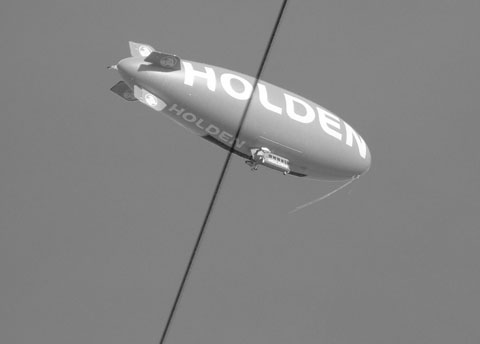Here’s a treat for (some of) you: the very first aerial warfare movie ever made, in its entirety! Most commonly known as The Airship Destroyer (but sometimes called Battle in the Clouds or The Aerial Torpedo), it’s less than 10 minutes long and was produced in 1909 by Charles Urban, an American pioneer of cinematic special effects working in Britain. It’s pretty prophetic stuff: airships bombing cities and railways, fighters intercepting them, radio-guided SAMs, even an armoured car thrown in for good measure. I would guess it was inspired in part by the phantom airship scare which took place earlier that year. Here’s a contemporary description taken from an American trade journal, Motion Picture World (date unknown, taken from here, slightly emended):
BATTLE IN THE CLOUDS. – Section 1. – preparation. The Aero camp – Loading supplies – Start of the airships – The inventor of the airship destroyer – His love story – The parting – The alarm – The aero fleet in full flight – The aerial torpedo and its inventor.
Section 2. Attack. In the clouds – Dropping like shells from the firing deck of an airship – the chase – High angle firing from a gun on an armored motor car – Total destruction of the car – Railway wrecked by the aerial fleet – Shelling the signal box – The heroic operator meets death at this post – The fight in the air – Airship versus aeroplane – Wreck of the aeroplane – The burning of a town by the aerial fleet – Thrilling rescue of his sweetheart by the inventor.
Section 3. Defense. The inventor with the assistance of his sweetheart sends his airship destroyer on its mission of vengeance. The torpedo, steered through the air by wireless telegraphy – One flash and the airship is doomed – It falls, a mass of scorching fire, into the waters of a lake.
Urban produced a couple of other films along similar lines (The Aerial Anarchists, The Pirates of 1920, both 1911) and had some imitators — possibly including D. W. Griffith, who made a film in 1916 called The Flying Torpedo.
The link can be found on this page at BFI’s screenonline, if the above direct link doesn’t work. Unfortunately it’s only viewable by people in .uk educational establishments. Which sadly doesn’t include me, but that’s ok, I’ve seen it before, in a 16mm copy at what I think is now part of ACMI. So no need to feel guilty on my account :)
A good account of early aviation films can be found in Michael Paris, From the Wright Brothers to Top Gun: Aviation, Nationalism and Popular Cinema (Manchester and New York: Manchester University Press, 1995), 10-22.
![]() This work is licensed under a Creative Commons Attribution-NonCommercial-NoDerivatives 4.0 International License.
Permissions beyond the scope of this license may be available at http://airminded.org/copyright/.
This work is licensed under a Creative Commons Attribution-NonCommercial-NoDerivatives 4.0 International License.
Permissions beyond the scope of this license may be available at http://airminded.org/copyright/.





That restriction by the Brits is tacky. I guess they would argue that it simplifies the IP issues, but they have hundreds rather than thousands of films up, and the older ones are surely not confined.
Also it is an early indication of the way in which the internet will cease to be universal as territorial ideas of IP are reasserted to deal with local rights.
I think that the restiction probably dervives from the fact that the copyright for the films was bought by JISC – the HE ICT body – for educational use only. JISC also give out .ac.uk domain names.
I imagine that if the BFI were buying copyright for all these films on a free to air basis, it would cost a packet: commercial rates are about twenty times the basic cost of digitisation, which itself isn’t cheap if you do it properly.
Is the issue perhaps less to do with copyright (which as David says, can hardly apply to a 1909 film made by companies and artists long since gone), and more to do with the attitude that as the rest of the world didn’t pay for the website, digitisation, etc (and British taxpayers, or perhaps lottery players did), they shouldn’t get to see it for free?
You’re right – it’s not JISC, but the lottery that’s funding it. Sorry everyone – I’d like to apologise (or at least express regret – but not offer reparations) on behalf of the UK.
Not good enough, Chris. Breaker Morant, Gallipoli, Bodyline, Singapore, Maralinga … and now this! It really is the last straw. I may not even offer the Queen cucumber sandwiches next time she visits.
Unfortunately I think it still is under copyright as Charles Urban didn’t die until 1942. That means it won’t be in the public domain in the UK until 1st January 2013. Let’s hope that on that day someone posts it on YouTube.
I would now like to express regret and sadness at UK copyright law. No, actually I’d like to express anger, defiance, and contempt…
Ah, that’s a good point. Of course, by 2013, the copyright period will no doubt have been extended by another decade or two ‘to protect the interests of the creator’s estate’. Won’t somebody please think of the great-great-grandchildren!
Pingback: Airminded · Screening the knock-out blow
I know it’s an old post so don’t know if you’ll see it, but aside from the varying quality copies on youtube, there’s a fantastic copy (with a rather weird 2008 soundtrack) online here;
http://www.europafilmtreasures.eu/PY/278/see-the-film-the_airship_destroyer
Rob,
Thanks for the cross-cite. The music(?) is rather odd, but for those of us not living in Britain, it’s a great opportunity to see the film.
The bad thing about silent films are the modern soundtracks. The good thing about silent films is the volume control!